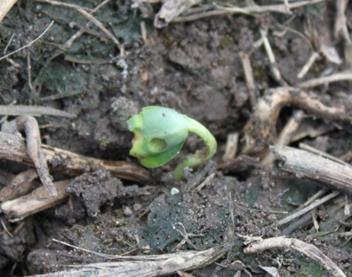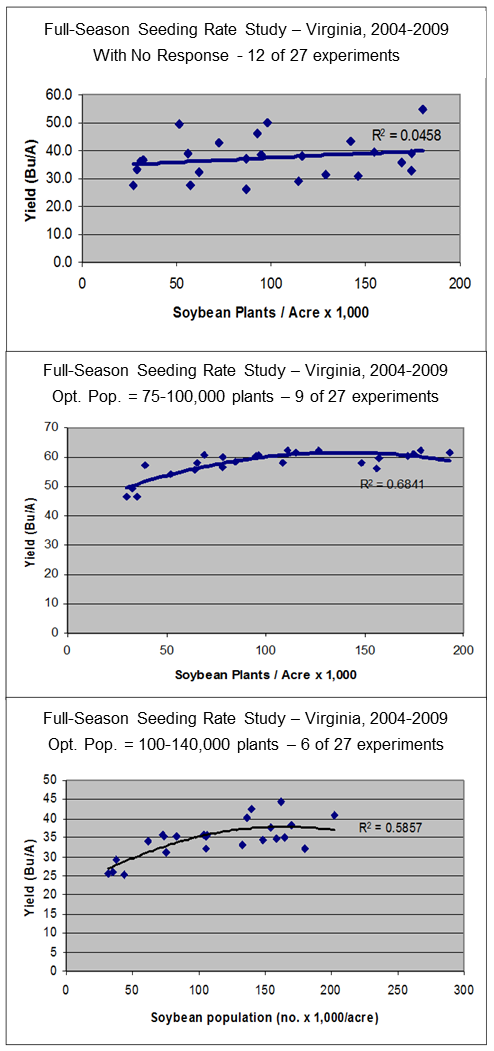Ames Herbert, Extension Entomologist
The kudzu bug situation has very quickly become a real problem for Virginia soybean producers. We are getting reports of infestations in the South Boston area and one from near Yale in Sussex County. I am quite sure that there are more infested fields. The image sent to me from the Yale field showed at least a dozen KB adults on a single plant. WHAT IS THE THRESHOLD and WHEN SHOULD YOU TREAT??? The treatment threshold for full grown R-stage plants has not changed (see below), but I have new information on thresholds for seedling/vegetative stage plants. Based on an experiment in GA, they (and others) are recommending treating at V2-V3 stage at an average of 5 bugs (adults and/or nymphs) per plant. The threshold increases to 10 bugs per plant for plants from 1-2 feet tall. The established threshold of one nymph per sweep (one swoosh of the net) should be used for plants above 2 feet tall. 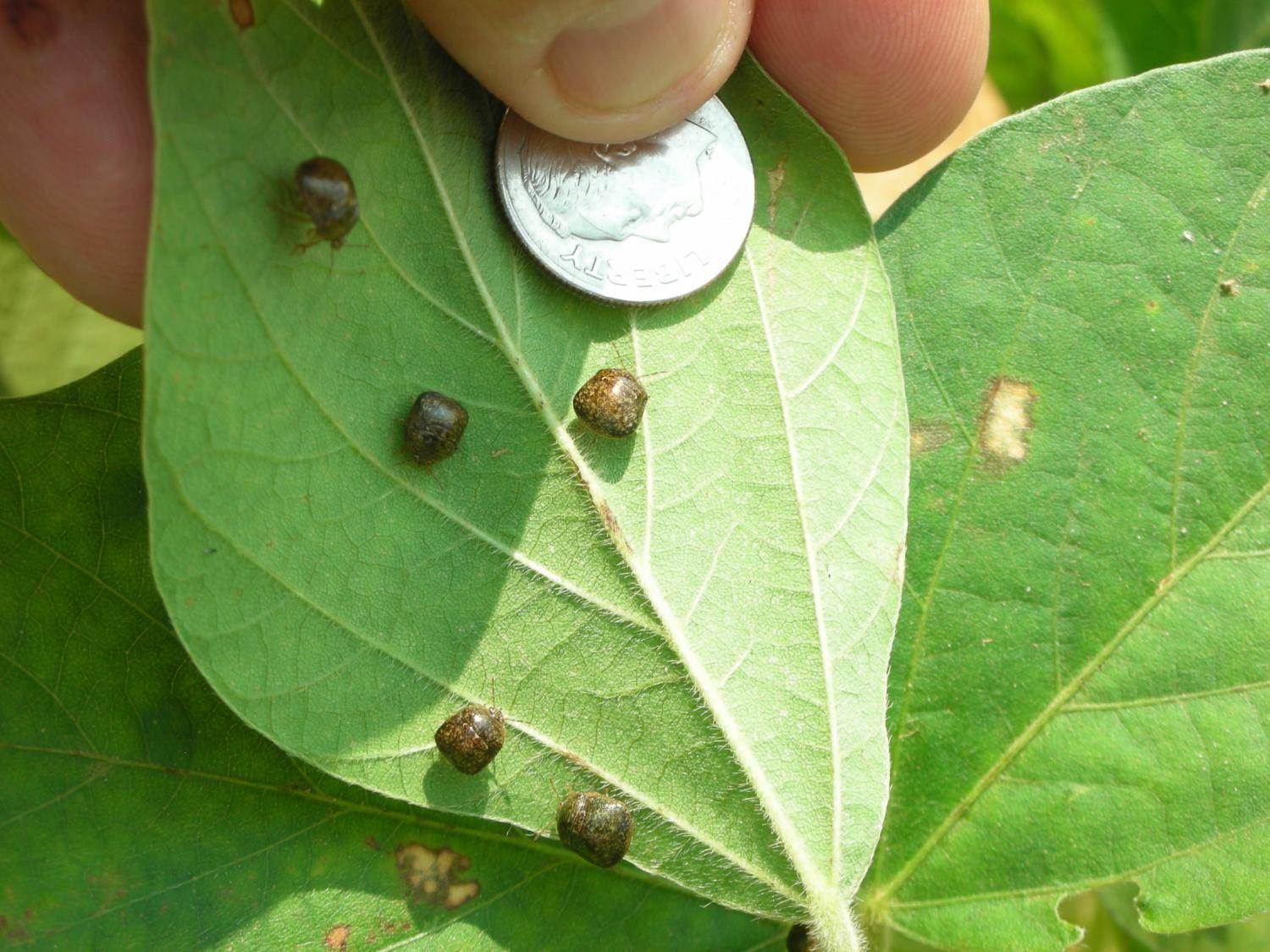 Plants should be sampled at least 50 feet from the edge of the field. The reason for this is that the adults have an extended migration period (6-8 weeks) and colonize field edges first. If you sample the edges, chances are you will make a spray decision too soon before the migration is over. They stress that these thresholds are PRELIMINARY and will absolutely change as we get more information. Here is a cautionary tale provided by Dr. Reisig at NCSU. A NC grower noticed kudzu bugs on the edge of his April-planted beans in May 2012. They had not yet infested the interior portions of the field. He opted to spray. He then had to spray again in June, as the adults remigrated into the field. Additionally, sprays don’t kill eggs, so these hatched into nymphs. The grower then had to spray a 3rd time in June, as spider mites were flared in the field from the lack of beneficial insects. We want to avoid these costly situations while still preserving our yield.
Plants should be sampled at least 50 feet from the edge of the field. The reason for this is that the adults have an extended migration period (6-8 weeks) and colonize field edges first. If you sample the edges, chances are you will make a spray decision too soon before the migration is over. They stress that these thresholds are PRELIMINARY and will absolutely change as we get more information. Here is a cautionary tale provided by Dr. Reisig at NCSU. A NC grower noticed kudzu bugs on the edge of his April-planted beans in May 2012. They had not yet infested the interior portions of the field. He opted to spray. He then had to spray again in June, as the adults remigrated into the field. Additionally, sprays don’t kill eggs, so these hatched into nymphs. The grower then had to spray a 3rd time in June, as spider mites were flared in the field from the lack of beneficial insects. We want to avoid these costly situations while still preserving our yield.
Monthly Archives: May 2013
Will Slugs Be A Problem in 2013?
Slugs are not a new problem, but they continue to be an unpredictable one. It seems that they show up when and where we least expect them and never show up when and where we do. But considering the cool and wet weather we’re experiencing, we should be on the watch.
The photo below was taken last May, 5 days after planting in a no-till field with a rye cover crop. Stand was about half of what was expected and feeding scars could be seen on the hypocotyl and cotyledons. When digging in the seed furrow, slugs were more often present than not.
Cold, wet weather slows seedling growth; therefore reducing the plant’s ability to outgrow slug damage. Slugs will feed on all crops, taking large chunks out of the stem and sometimes cutting the plants like a cutworm. They feed mostly at night although I’ve seen them feeding during cloudy days (see photo below). In general, they are more of a problem in wet, poorly drained fields or in low-lying portions of fields. Still, we’ve seen them on hilltops. 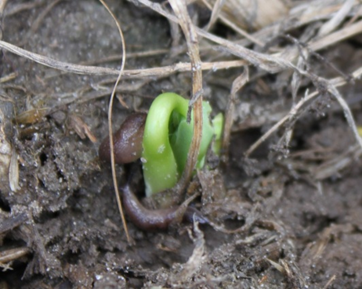 They are usually a problem in no-till fields with high residue crops such as corn or grain sorghum and/or in fields the slug underneath last year’s corn stalk. If the seed furrow doesn’t fully close, slugs will follow this “highway” and eat seedling after seedling before it emerges from the soil.
They are usually a problem in no-till fields with high residue crops such as corn or grain sorghum and/or in fields the slug underneath last year’s corn stalk. If the seed furrow doesn’t fully close, slugs will follow this “highway” and eat seedling after seedling before it emerges from the soil.
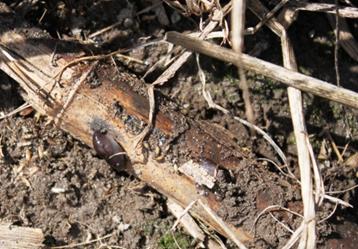 What can be done about this problem? First, scout the field before you plant, paying close attention to poorly drained or low-lying portions of the field. If you find slugs, you have a couple of options. One is to not plant and wait for warmer and dryer weather. Slug damage usually disappears under warm and dry conditions.
What can be done about this problem? First, scout the field before you plant, paying close attention to poorly drained or low-lying portions of the field. If you find slugs, you have a couple of options. One is to not plant and wait for warmer and dryer weather. Slug damage usually disappears under warm and dry conditions.
Another alternative is to apply the slug bait/molluscicide, Deadline®, which contains the active ingredient metaldehyde. It is sold at Deadline® M-Ps™ Mini-Pellets (colored with a blue dye) and Deadline® Bullets (dye-free). This is the only reliable treatment that we have available. It must be spread evenly at 10 to 40 lbs per acre over the infested area. The product is fairly expensive, so the 10 lb rate is the most common and has worked well in my experience. The product is not commonly stocked by local retailers, so it can be hard to find.
Will slugs be a problem? Maybe. Maybe not. But, with the current weather conditions, I’d suggest scouting those slug-prone fields.
Full-Season Soybean Seeding Rates
My soybean seeding rate recommendation for full-season production systems is to plant enough seed to insure 80,000 uniformly spaced plants/acre. If you cannot uniformly space the plants within a row, then my recommendation rises to 100,000 plants/acre. Based on numerous seeding rate experiments conducted in Virginia, I feel very confident in this recommendation.
Of the 27 full-season seeding rate experiments conducted from 2004 to 2009, I can group soybean yield response to plant population into the following three categories: 1) no response to plant population; 2) optimum plant population of 75-100,000 plants/acre; and 3) optimum plant population of 100-140,000 plants/acre. Below are individual tests that represent these categories.
First, note that these examples only show the response of yield to plant population and do not take into account seed costs. When seed costs are included, the optimum plant population is lower than is shown on the graphs. Also note that these graphs show yield response to plant population, not seeding rate. To convert to seeding rate, adjust these numbers to reflect your expected percent emergence. For example if you assume 75% emergence, you would need to adjust your seeding rate to 133,000 seed/acre to obtain 100,000 plants/acre.
We conducted these experiments with maturity group 4 and 5 varieties. While one may think that more seed might be required for early-maturing varieties, this was not the case (i.e., group 4 and 5 varieties responded similarly).
There may be some correlation with yield potential as listed below:
- 30-40 Bu/A Yield Potential (14 tests)
- 6 required 100-130,000 plants/acre
- 2 required 70-100,000 plants/acre
- 6 had no yield response
- 40-60 Bu/A Yield Potential (7 tests)
- 2 required 70-100,000 plants/acre
- 5 had no yield response
- > 60 Bu/A Yield Potential (7 tests)
- 2 required ~130,000 plants/acre
- 4 required 70-100,000 plants/acre
- 1 had no yield response
So, what do these data mean? It means that every environment (year & location) is a little different and there is no way that we can predict with 100% accuracy the exact seeding rate that will be required for your field in the coming growing season. However, we do know that if we can obtain full canopy closure (90-95% light interception) by full flower (R2 stage) to early pod (R3 stage), we can maximize soybean yield potential. In a dry year or under a droughty soil (low yield potentials), greater seeding rates will help insure this. Still in most cases (30 to 60 bushel yield potentials), 70-100,000 plants/acre are adequate.
What about fields with greater than 60 bushel yield potential? In this case, we need to look beyond adequate leaf area and need to start thinking about how many pods the soybean plant can support. For instance, at 40 bushels/acre and 100,000 plants/acre, we only need to produce 72 seed/plant (using 3000 seed/lb) or about 30 pods/plant (using 2.5 seed/pod). But, at 60 bushels/acre, we need to produce 108 seed or 45 pods per plant; at 80 bushels/acre, we need 144 seed or 60 pods per plant. Considering that 12 reproductive nodes per plant are possible, 4 to 5 pods per node on a rather tall plant would be required. Although branching will also contribute to yield, that seems a lot to ask of one soybean plant. So, if you are trying to win the yield contest or are irrigating soybean, I suggest planting enough seed to obtain 120-140,000 plants per acre in a full-season system; otherwise 80-100,000 plants are adequate.
Cool Soils Should Alter Your Planting Plans
It goes without saying that every year is different and this winter/spring has been wet and cold. I think that most of us have assumed that the soil temperatures are much below normal; therefore, holding off a few days with planting may be a good idea. According to 2013 and five-year historical soil temperature records at Orange and Suffolk (from the USDA-NRCS Soil Climate Analysis Network weather stations), soil temperatures have been fluctuating quite a bit.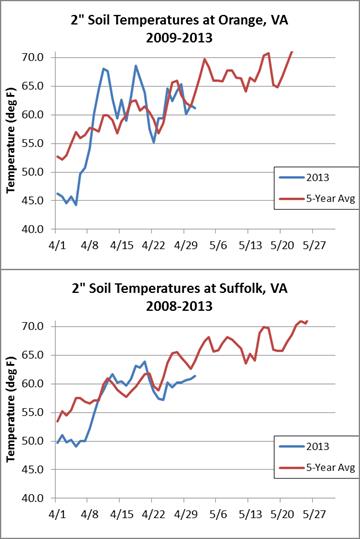
After early-April soil temperatures proved to be much colder than normal, a week or two of warm weather put us back on track with average. Then, temperatures dropped off again. Fortunately, the last two weeks of cool weather have not lowered the soil temperatures all that much.
Although our soils have warmed substantially since early April, the temperatures are still less than optimum for soybean germination and emergence. Ideally, I like to see temperatures hold steady at 65 to 70O or above. The ideal temperature for soybean germination is 77O and the optimum range is 68 to 86O. The maximum is 94O, where germination can be inhibited. However, we can’t always wait for perfect temperatures if we are to get all of our soybeans planted on time.
Still, planting soybean in cool (<65O) will lead to delayed emergence and increased chance of seedling disease that can reduce stands, weaken emerged plants, and inhibit early-season growth. For a more detailed description of fungal seedling disease in soybean, refer to an article I wrote last May on the subject and can be found in my Virginia Soybean Update blog.
I stress that the greater time required for emergence, the greater probability that the seed will become infected with soil-borne disease. If you are planting into cool soils, I strongly suggest using fungicide-treated seed as an insurance against seedling disease. These treatments will protect the seed and seedling if emergence is delayed.
But, seed treatments should not be a substitute for other practices that encourage rapid seedling emergence. Here is my checklist for insuring a good stand free of seedling disease:
- Know the germination and vigor of your seed; adjust the seeding rate accordingly.
- Insure good soil-to-seed contact by properly setting your planter to cut through the residue and penetrate to the proper depth.
- Plant soybean seed ¾ to 1 inch deep into good soil moisture.
- Consider fungicide seed treatments if planting into cool soils.

